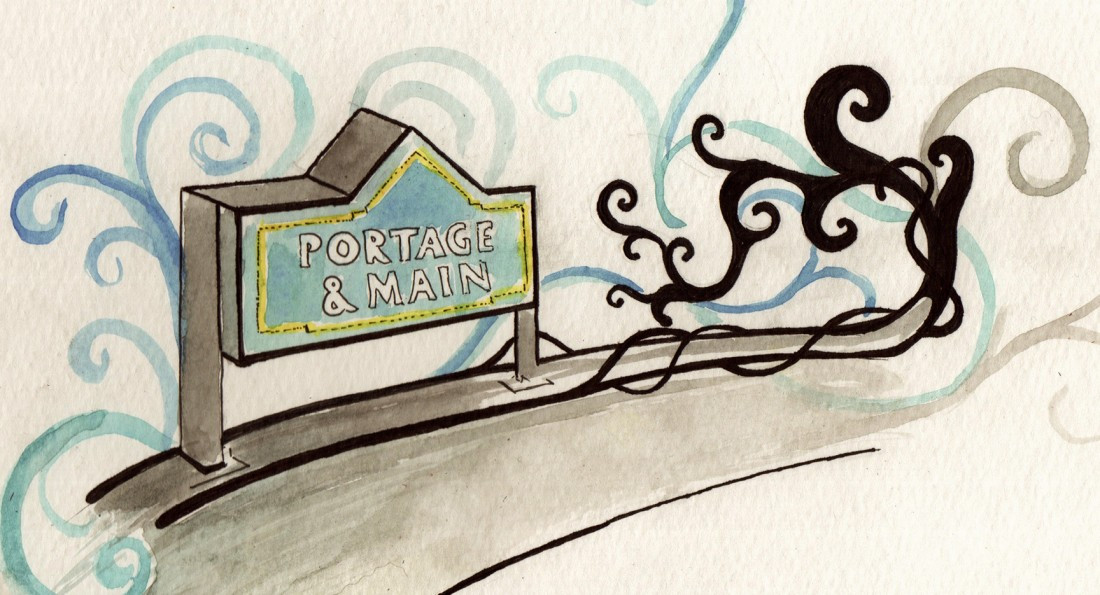Middle of Nowhere
Portage and Main is our public square
The first time I stood on the pavement at Portage and Main, the ground felt hard under my boots.
It wasn't any harder than Portage and Vaughan or Main and Bannatyne I'm sure, but there was something about standing in a spot not meant for human soles that made me notice my feet.
The crossroads has been closed to pedestrians since 1979, when then-mayor Stephen Juba’s administration erected barriers, apparently choosing the city’s drivers over those who walk.
But despite the intersection’s off-limits status, it’s remained a sort of public square, a gathering place where Winnipeggers congregate to assert themselves, whether in celebration of the return of the Jets or in solidarity with Dakota Access Pipeline protesters.
There’s some symbolic heft to this gathering place. It’s where the city’s main arteries converge, and stopping traffic lends the feeling of bringing the city to a halt, as it did during an Idle No More round dance in 2012.
It’s where, in 1919, “aliens, bohunks and foreigners” were assaulted by police during one of the largest general strikes in Canadian history.
Whether justifiably or not, we take weird pride in the intersection as one of the coldest and windiest in the country. “I would say it’s the windiest and coldest intersection on the planet,” Colorado Avalanche reporter Kyle Keefe said recently. “Just being out here, I feel like I might die.”
It has a spot on the 2000 edition of Canadian Monopoly and it graces the can of Fort Garry Brewing Co.’s Portage and Main IPA.
Yet today Portage and Main is impassable to anyone without a vehicle, and the underground concourse of a crosswalk is particularly inaccessible to people with disabilities. For people who can’t use stairs, a trip across the street takes back corridors and no less than five elevators, one of which was out of order this past fall.
Coun. Ross Eadie told Metro Winnipeg that the route underground can’t possibly be navigated by a person with complete vision loss.
So why, in an era when study after study has demonstrated the cultural, judicial and economic benefits of a pedestrian-friendly city centre, is this staple of Winnipeg’s culture and history still designed to discriminate against those without vehicles?
A growing number of Winnipeggers would like to see the intersection opened, despite efforts from organizations like CAA to convince the public otherwise.
Defenders of the status quo tend to cite traffic and expense as rationale for barring residents from their streets.
Habitual active transport critic Coun. Jeff Browaty recently told reporters that opening the intersection would cost Winnipeg Transit millions by slowing down its fleet, ignoring the likely upshot of increased ridership and revenue with easier pedestrian access.
The Winnipeg Sun published reader Gord Higham’s opinion that “climate change hypocrites” are overlooking the “thousands upon thousands of vehicles day after day pumping out tonnes of CO2 and other greenhouse gases while stuck in a perpetual gridlock of idling engines.”
Meanwhile, Rick Sparling, columnist for The Herald, “managed to find [his] way around despite alack [sic] of obvious signage,” and thinks Portage and Main is “just fine the way it is.”
But for those who aren’t convinced that Winnipeg is “just fine the way it is,” who don’t think expediting vehicles will end climate change, and who do want to live in a city with an accessible and bustling downtown, one next step is obvious: reopen Portage and Main.
Tim Runtz is the comments editor at The Uniter. His regular column Middle of Nowhere explores the culture and politics of places around Winnipeg.
Published in Volume 71, Number 15 of The Uniter (January 12, 2017)








